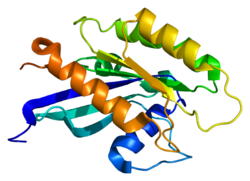프로푼달 지대
Profundal zone| 호수 구역 |
|---|
| 호수층화 |
| 호수형식 |
| 참고 항목 |
폭포수역은 호수나 연못과 같은 자유수역 내륙의 깊은 구역으로, 효과적인 빛의 침투 범위 아래에 위치한다. 이것은 일반적으로 온도가 급격히 떨어지는 물 속 수직 영역인 열경선 아래에 있다. 온도 차이는 산소의 농도 저하를 야기하는 어떤 계절에는 연근대와의 혼합을 방해할 정도로 충분히 클 수 있다.[1] 폭포는 종종 가장 깊고, 초목이 없고, 진흙투성이의 라쿠스린 벤탈 구역으로 정의된다.[2] 폭식 지역은 종종 진딧물 구역의 일부분이다. 폭포 지역의 침전물은 주로 실트와 진흙으로 이루어져 있다.[1]
유기체
폭포수역에서의 빛과 산소 부족이 이 지역에 살 수 있는 생물공동체의 유형을 결정하는데, 이는 폭포수역에서의 공동체와는 확연히 다르다.[3] 그러므로 다량의 매크로파우나는 낮은 산소 농도에 대한 생리적 및 행동적 적응에 의해 특징지어진다. 벤트닉 파우나는 호수마다 다르지만, 치로노미대와 올리고차이에테는 산소가 부족한 물에서 산소를 추출하기 위해 헤모글로빈과 같은 분자를 보유하고 있기 때문에 종종 프로파간다 지역의 벤트릭 파우나를 지배한다.[4] 생물체는 다층존의 낮은 생산성으로 인해 광자존에서 침하되는 쓰레기통에 의존한다.[1] 폭식존의 풍부한 종은 림프존의 것과 비슷한 경우가 많다.[5] 다량의 벤토에 있는 미생물 수치는 연골 벤토보다 더 높으며, 잠재적으로 더 작은 평균 침전물 입자 크기 때문이다.[6] Benthic macroinvertebrate는 하향식 압력에 의해 조절되는 것으로 여겨진다.[7]
영양분 순환
다원성 구역의 영양 유량은 주로 벤토로부터의 방출에 의해 구동된다.[8] 프로파운달 구역의 무산화 성질은 벤트식 침전물로부터의 암모니아 방출을 촉진한다. 이것은 식물성 플랑크톤 생성을 식물성 플랑크톤 꽃을 피울 정도로 촉진시킬 수 있고, 특히 높은 pH에서 많은 유기체에게 독성 조건을 만들 수 있다. 하이폴림네틱 아나옥시아는 또한 다량의 철분, 망간, 황화물의 발생에 기여할 수 있다.[9]
참고 항목
참조
- ^ a b c Dodds, Walter K. (Walter Kennedy), 1958- (15 February 2019). Freshwater ecology : concepts and environmental applications of limnology. Whiles, Matt R. (Third ed.). London, United Kingdom. ISBN 9780128132555. OCLC 1096190142.
{{cite book}}: CS1 maint : 복수이름 : 작성자 목록(링크) - ^ Thienemann, August (1925). Die Binnengewässer Mitteleuropas. eine limnologiche Einführung [The Inland Waters of Central Europe: a Limnological Introduction]. Die Binnengewässer (in German). Vol. 1. Stuttgart: E. Schweizerbart'sche Verlagsbuchandlung. OCLC 859570299.
- ^ Thienemann, August (1920). "Untersuchungen über die Beziehungen zwischen dem Sauerstoff gehalt des Wassers und der Zusammensetzung der Fauna in norddeutschen Seen" [Studies on the Relationship Between the Oxygen Content of Water and the Composition of Fauna in Northern German Lakes]. Archiv für Hydrobiologie (in German). Stuttgart: E. Schweizerbart'sche Verlagsbuchandlung. 12: 1–65. ISSN 0003-9136.
- ^ Int Panis, Luc; Goddeeris, Boudewijn; Verheyen, Rudolf (January 1996). "On the relationship between vertical microdistribution and adaptations to oxygen stress in littoral Chironomidae (Diptera)". Hydrobiologia. 318 (1–3): 61–67. doi:10.1007/bf00014132. S2CID 27026595.
- ^ Vadeboncoeur, Yvonne; McIntyre, Peter B.; Vander Zanden, M. Jake (July 2011). "Borders of Biodiversity: Life at the Edge of the World's Large Lakes". BioScience. 61 (7): 526–537. doi:10.1525/bio.2011.61.7.7. ISSN 1525-3244.
- ^ Jones, J. G. (1980-04-01). "Some Differences in the Microbiology of Profundal and Littoral Lake Sediments". Microbiology. 117 (2): 285–292. doi:10.1099/00221287-117-2-285. ISSN 1350-0872.
- ^ Jyväsjärvi, Jussi; Immonen, Hemmo; Högmander, Pia; Högmander, Harri; Hämäläinen, Heikki; Karjalainen, Juha (2013). "Can lake restoration by fish removal improve the status of profundal macroinvertebrate assemblages?". Freshwater Biology. 58 (6): 1149–1161. doi:10.1111/fwb.12115. ISSN 1365-2427.
- ^ Beutel, Marc W.; Horne, Alex J.; Taylor, William D.; Losee, Richard F.; Whitney, Randy D. (March 2008). "Effects of oxygen and nitrate on nutrient release from profundal sediments of a large, oligo-mesotrophic reservoir, Lake Mathews, California". Lake and Reservoir Management. 24 (1): 18–29. doi:10.1080/07438140809354047. ISSN 1040-2381. S2CID 85189740.
- ^ Beutel, Marc W. (December 2006). "Inhibition of ammonia release from anoxic profundal sediments in lakes using hypolimnetic oxygenation". Ecological Engineering. 28 (3): 271–279. doi:10.1016/j.ecoleng.2006.05.009. ISSN 0925-8574.

